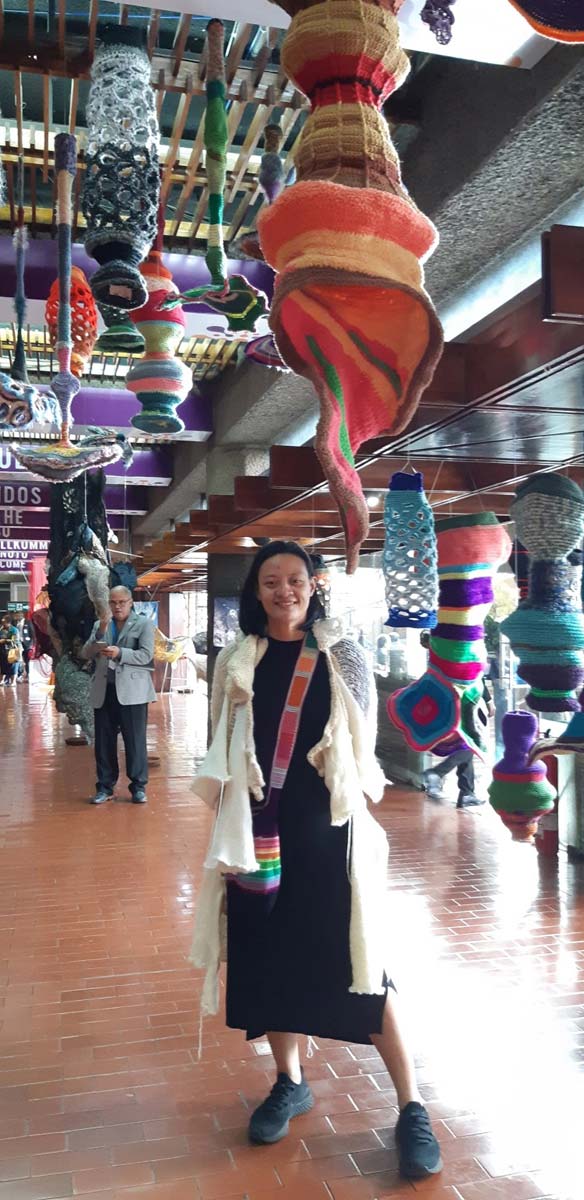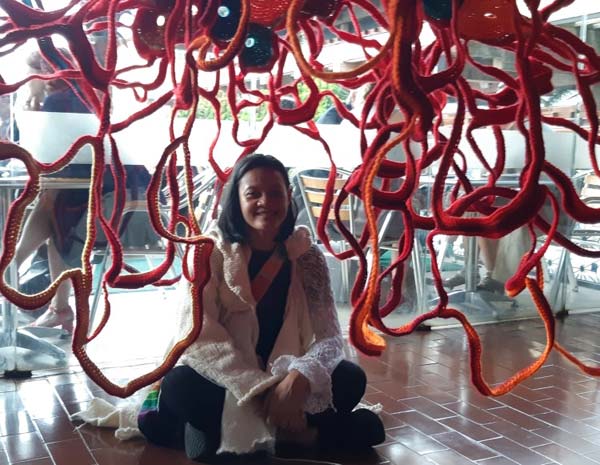Visual artist tells women’s stories in crochet, Women Writing Women
Aze Ong has been crocheting since she was 12. Growing up, she perfected the craft that, nine years ago, she told her father that this is what she wanted to do for the rest of her life.
“His face turned into a question mark,” said Ong metaphorically of her father’s reaction to her life-plan. “(But) the statement I made was strong and that he knew I was not asking a question.” Conscious that she was happy honing the skill that many people consider only as a female hobby, she continued from where she started, having been taught crochet in the technology and home economics subject in an all-girls school. She also learned about the basic and complex patterns, at a time when there were still no YouTube tutorials.
In 2010, her would-be mentor, artist Lirio Salvador, opened her eyes to the potential of her skill. “I never knew it until he told me I was making art,” Ong said. Using fiber as a medium, she discovered she could turn macrame, sewing, knitting, knotting, embroidery and weaving into art.
A left-handed visual artist, she saw her craft flourished into various forms and then exhibited in many different venues, including in the recentlly-concluded Nairobi Summit on ICPD 25 in Nairobi, Kenya in mid-November 2019. The historic high-level conference, organized by the United Nations Population Fund (UNFPA) and the governments of Denmark and Kenya, marked the 25 years of the International Conference on Population and Development held in Cairo in 1994, where 179 countries agreed to a program of action that shifted the discussion of population and development from demographics-centered to a human-centered program.
Joining other countries, the Philipines promised to implement the commitments it made 25 years ago that focused on providing women full access to family planning information and services, preventing maternal deaths, and preventing sexual and gender-based violence and harmful practices against women and girls.
Around 8,000 people, consisting of world leaders, parliamentarians, development planners, thought leaders, civil society and community organizations, academics, financial institutions, young people and all those who have a stake in reproductive and sexual health and rights passed by Ong’s art installation at Nairobi’s Kenyatta International Convention Center (KICC).
The exhibit, called “Fabric of Being,” was an idea of Dr. Natalia Kanem, executive director of the UNFPA, and organized by Dr. Rosalia Sciortino Sumaryono of SeaJunction, a Bangkok-based art exchange venue, for the Nairobi Summit. It featured artwork from 13 artists all over the world, including Ong’s. Her installation, “Gender Metamorphosis: Aze Ong, The Philippines,” was made up of more than 50 intricate and colorful crochet pieces hung from the ceiling of KICC’s central walkway leading to the conference rooms.

Aze Ong and her artwork
Made from chenille, cotton, acrylic, bamboo, silk, furry and wool, the installation conveyed images and symbolisms of the multiple roles of women and the changes that their experiences create. Ong’s visual art also represented the complex communities of the Philippine archipelago, making many Filipino delegates in the conference proud of Ong making waves in the international art and political arena.
Ong said she calls her art works “Liwanag” as it represents the light. “I use different threads, yarns and fiber and the general technique I use is crochet. I also incorporate sewing, knotting, knitting, embroidery, and the likes to the works,” she said.
A graduate of Assumption College with a degree in communication, major in media production, Ong was born in Biñan, Laguna and grew up in Antipolo. In 1999, after graduating from college, she volunteered for the Associate Missionaries of the Assumption. She was assigned as a teacher in Kibangay, Bukidnon where most of her students belonged to the Talaandig tribe. She credited the indigenous community for “enriching my experience and having had a big influence in my art.”
The contemporary visual artist is also an Asian Cultural Council grantee and had recently had her residency at Bliss on Bliss Art Projects in New York where she created a “rolling sculpture” which she walked thru the streets of Queens and Manhattan.
Ong valued the time spent among reproductive and sexual health stakeholders in the Nairobi summit because she believes in its agenda. “Sexual, reproductive health and rights should be exercised. A woman’s body is her own, she should be able to decide for herself and that information about it should be widely available,” she said. “Educating women will help us make a choice for ourselves.”

“To be able to fight for my art is exercising my right – as a human being, as a woman. I am in control of my body and my choices.”
She confronts tensions brought by her art and her being female. “There are challenges of a medium associated with women, and art being created by a woman,” she said. In 2010, some artists told her that she will not be able to sustain her art and then told her to just give up. Others asked her to change her medium to painting. She refused.
“I am a visual artist, I use fiber as a medium, this is what I want to do for the rest of my life and this is what makes me happy,” she said. “To be able to fight for my art is exercising my right – as a human being, as a woman, I am in control of my body and my choices.”
Source: https://womenwritingwomen.com/2019/11/25/visual-artist-tells-womens-stories-in-crochet/
